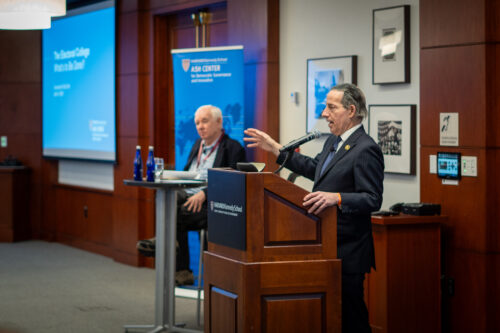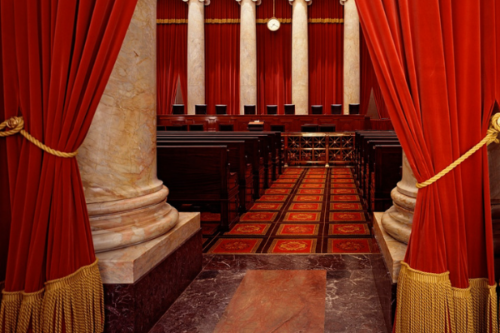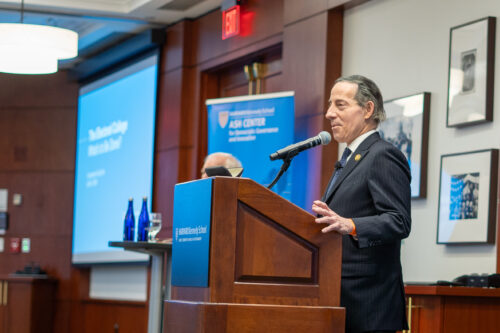
Feature
Moving beyond the Electoral College
At an Ash Center symposium on Electoral College reform, Congressman Jamie Raskin makes the case that the US should finally move to a direct popular vote for selecting presidential winners.
Feature
Scholars conclude terms limits would help restore ideological balance to the nation’s highest court
Writing in the Southern California Law Review, HKS Professor of Public Policy Maya Sen, along with University of Chicago’s Adam Chilton, and Daniel Epps and Kyle Rozema of Washington University in St. Louis, provide an assessment of the impact that various term limit proposals would have on the composition of the Supreme Court.
As public dissatisfaction with the Court has grown, so too has the chorus of reform proposals that would fundamentally reshape how justices are appointed. “Many have found the case for term limits persuasive: commentators, politicians across the political spectrum, and even the American public have all expressed support for term limits,” write Sen and her co-authors in Designing Supreme Court Term Limits. Term limits, proponents argue, would prevent Justices from retiring strategically in order to try to maintain their party’s ideological advantages on the Court.
While term limit proposals differ in important ways, such as how the transition to the new system would work, most would have Justices serve for eighteen years with their tenures staggered so that two appointments would be made each presidential term. Although term limits appear to enjoy broad bipartisan support and also to be gaining traction among some on Capitol Hill, many discussions have been silent on many key design decisions, such as what would happen should the Senate refuse to consider a president’s nomination. Further, few have studied how this proposal would affect the actual composition of the Supreme Court.
The authors believe there are four design choices for term limit proposals that policymakers should consider when drawing up eighteen-year term-limit plans:
Sen, Chilton, Epps, and Rozema find that term limits are likely to produce dramatic changes in the ideological composition of the Court. While life tenure ostensibly insulates justices from political pressure, the authors argue that “it also results in unpredictable deaths and strategic retirements determining the timing of Court vacancies.” The Supreme Court, for example, has had extreme ideological imbalance for sixty percent of the time since President Franklin Roosevelt’s effort to pack the Court. Any of the major term-limits proposals floated in recent years would have reduced the amount of time with extreme imbalance by almost half. “If the goal is to prevent the Supreme Court from becoming ideologically extreme, then term limits would probably do a very good job with that,” added Sen.
Written by Daniel Harsha, Associate Director of Communications and Strategic Initiatives
Feature
At an Ash Center symposium on Electoral College reform, Congressman Jamie Raskin makes the case that the US should finally move to a direct popular vote for selecting presidential winners.
Feature
During an opening panel at an Ash Center symposium on the future of the Electoral College, scholars examined the history behind how the US adopted its peculiar centuries-old system of choosing presidential election winners – and what should be done to reform or even abolish the practice today.
Video
Harvard-ID holders were invited to join the Ash Center for Democratic Governance and Innovation and the Institute of Politics for a conversation with Congressman Jamie Raskin (MD-08) about the future of the Electoral College.
Feature
At an Ash Center symposium on Electoral College reform, Congressman Jamie Raskin makes the case that the US should finally move to a direct popular vote for selecting presidential winners.
Feature
During an opening panel at an Ash Center symposium on the future of the Electoral College, scholars examined the history behind how the US adopted its peculiar centuries-old system of choosing presidential election winners – and what should be done to reform or even abolish the practice today.
Video
Harvard-ID holders were invited to join the Ash Center for Democratic Governance and Innovation and the Institute of Politics for a conversation with Congressman Jamie Raskin (MD-08) about the future of the Electoral College.


